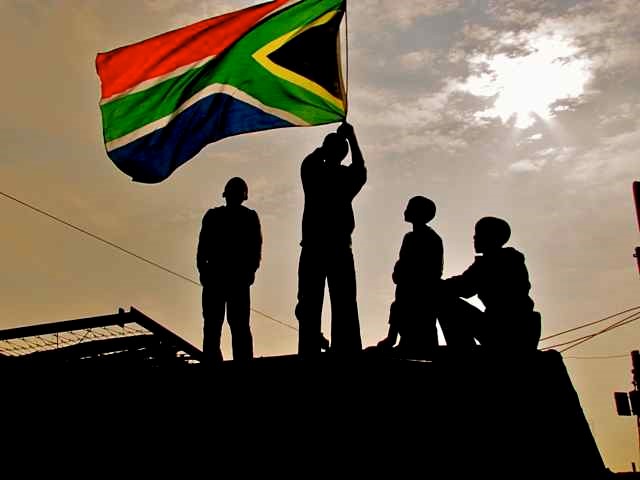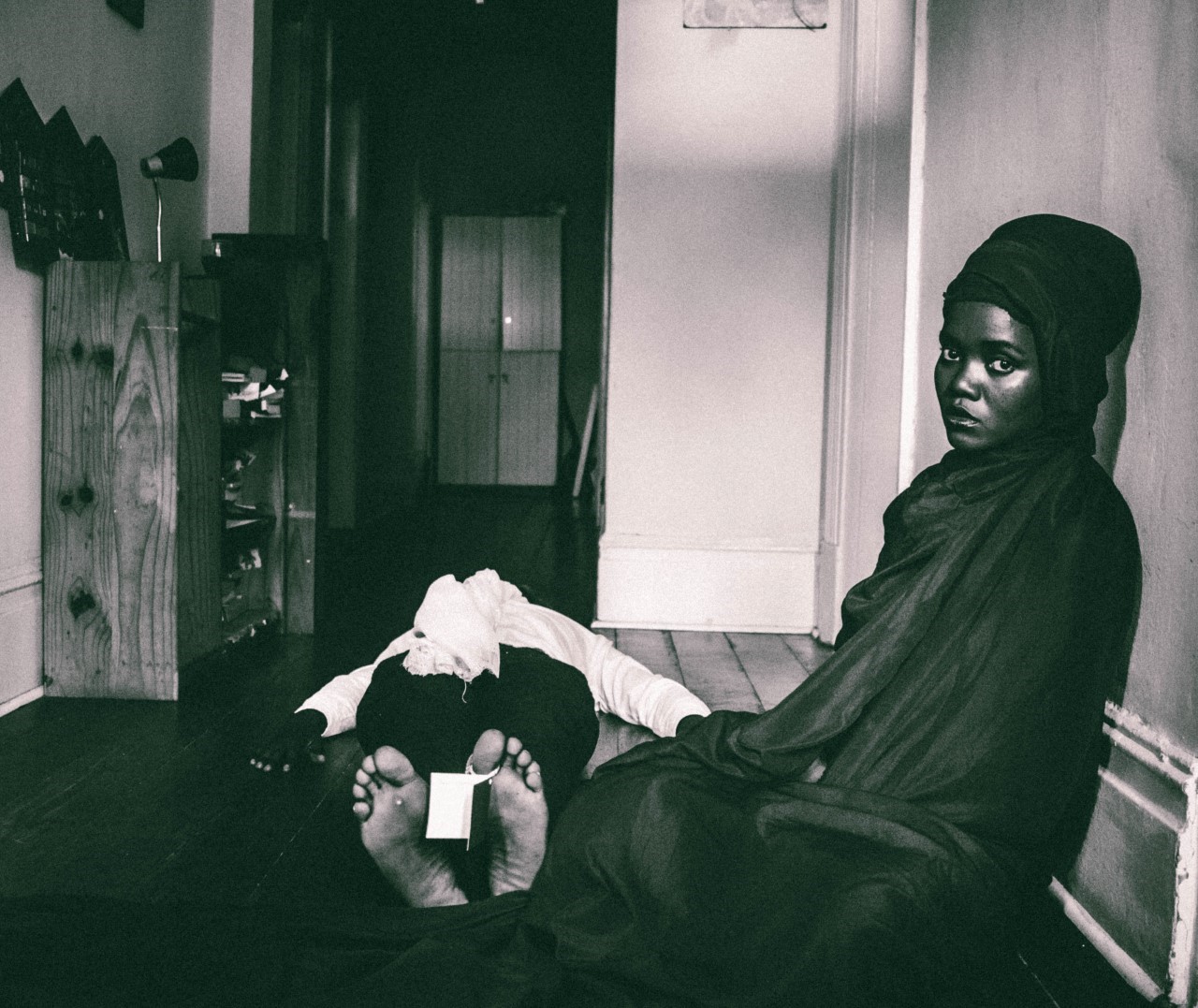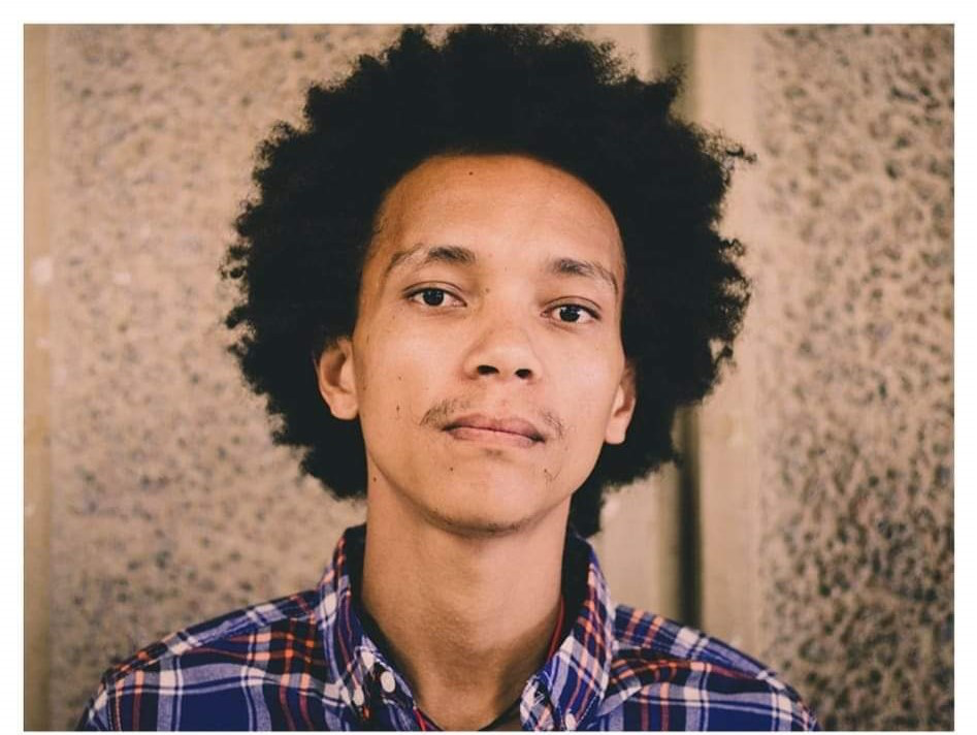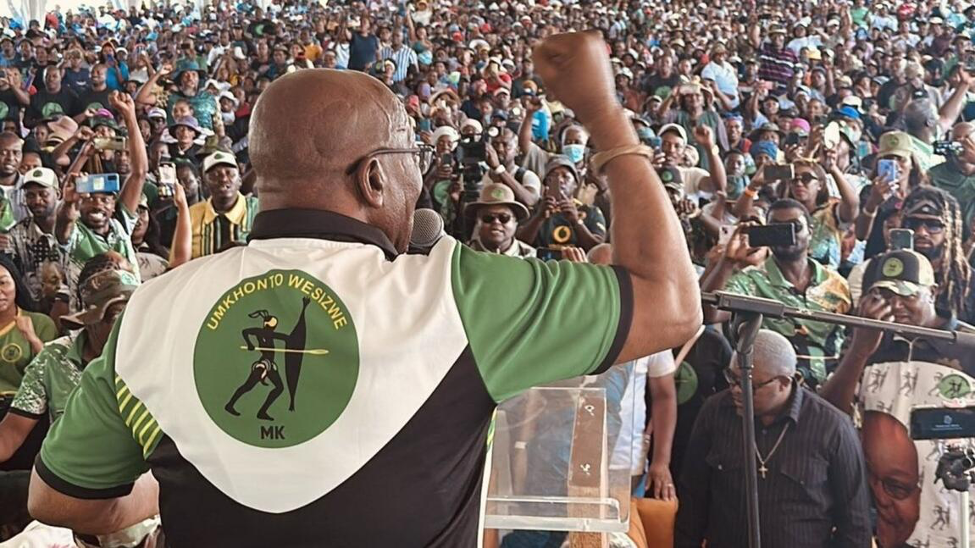“I do not want to rainbow without bread, I do not want to hate Cecil and anthem with his children” “I do not want to white anymore…white demons drowning in the Atlantic” Makhafula Vilakazi in Words 2022.
The annoying persistent fantasy of the rainbow nation has been subjected to a popular critique. Its banality has seen even the so-called born-frees who are its supposed beneficiaries indicating some kind of discomfort with it. Of course, in the light of what the current constitution provides in its Words in terms of socio-economic rights and the need to redress the “injustices of the past” it is easy to criticise the rainbow nation. The horrendous material existence of the Afrikan majority does not match the “progressive” socio-economic aspirations of the current constitution. It is this glaring contradiction which a lot of the critique of the fantasy of the rainbow nation relies on. The cliché example of the material disparity between Sandton and Alexander as empirical evidence of this contradiction which results in cognitive dissonance comes in handy in this at times opportunistic but mundane critique. This is what entails the critique of the fiction of the rainbow nation from the perspectives of political economy and constitutional critique.
But the current ridiculously embarrassing celebration of the Springbok’s win of the world cup by the same Afrikan majority who are historical and daily victims of racism/ white supremacy in a white settler colony called South Africa necessitates a different approach to the critique of the rainbow nation. We need to explain the absurd contradiction between the general critique of the fiction of the rainbow nation and the annoying embrace of the children of Cecil by the Afrikan majority. We are not here interested in a detailed critique of the fantasy of the rainbow nation. But we want to use the example of this fiction to provide a different analysis of the underlying reason why the Afrikan majority is not restoring the land and national self-determination. The outdated criticism of the leadership of the ANC as having sold out the Afrikan majority during the so-called negotiations and the constitution being anti-black and reinforcing racism is proving to be insufficient. It is true that Mandela and his comrades as “civilised natives” betrayed the Afrikan majority and that the current constitution is based on the epistemological paradigm of the European conqueror and therefore racist. But there is something about “the structure of feelings” of the Afrikan people that must be interrogated to explain the absence of revolution to restore the land and national self-determination by the Afrikan majority. It is in this sense that we argue that while the political economy and constitutional critique are dominant in the discourse on the nature of South Africa as white settler colony, the libidinal economy critique is marginalised. While the political economy critique emphasises the economic exploitation of the Afrikan majority by “white monopoly capital” as a white settler colonial mode of production which was introduced through conquest since 1652, the constitutional critique focuses on the nature and the text of the constitution to account for the persistence of historic injustice and inequality in the so-called post-Apartheid South Africa.
A good analytical framework must guard against the overemphasis of either the structure or the agency of the victims of the structure of domination and exploitation. Many discourses by the victims of structures of domination and exploitation tend to overemphasise the structure when analysing their condition. The political economy critique tends to overemphasise the exploitative nature of “white monopoly capital” while the constitutional critique tends to focus on the problematic nature of the text or content of the constitution to account for poverty and inequality. Of course, we are aware of Kwame Ture’s wisdom that every analysis of the condition of the oppressed must include the oppressor, otherwise it will place all the blame on the oppressed. But there comes a point when the oppressed must have a frank and unapologetic conversations about their collective weaknesses which may account for the persistent condition of oppression and domination by their oppressor. The Afrikan majority must reach a point where they are willing to “tell no lies and claim no easy victories” as Amilcar Cabral advised, about their condition of exploitation and domination by white settlers in South Africa. Blaming Mandela and the constitution are no longer sufficient reasons to account for the failure to restore land and national self-determination. Yes, Mandela and his ANC sold out and indeed, the constitution for example through section 25 is anti-black and stands in the way of the Afrikan majority’s attempts to restore the land and national self-determination. But for how long are we going to blame Mandela who is gone and the ANC which has proven since 1994 that it is not willing to restore the land and national self-determination? How long are we going to blame the text of the constitution for our inability to restore the land and national self-determination? The “deal” that Mandela and the ANC struck with white settlers during the so-called negotiations and the text of the constitution are just documents or Words as Makhafula Vilakazi would put it, which the Afrikan majority can ignore if we are serious about taking what rightfully belongs to us. Our demographic majority power and revolutionary determination cannot be stopped by mere formal documents or Words. The so-called land invasions by some desperate and brave members of the Afrikan majority is a simple example to demonstrate that we have the ability to ignore the CODESA deal and the Words of the constitution to advance towards the ultimate restoration of the land and national self-determination. So, what is standing in our way of attaining Afrikan liberation from white settlers?
In terms of our libidinal economy critique, we argue that the Afrikan majority including many black radical intellectuals must admit that due to conquest in a series of barbaric race wars by savage white settlers, the majority of the Afrikan people love and/or fear whites. Blaming Mandela’s ANC and the Words of the constitution is a way in which the Afrikan majority and the radical black intellectuals avoid admitting the undying love for whites and the sick collective fantasy of co-existing with them as equals and human like them. Many of these traitorous intellectuals are hopelessly and helplessly fantasising about and dating white girls. They are leaders in the pathological collective fantasy of being loved and accepted by white demons from the Atlantic. Apart from the material structure of capitalism and rights discourse, conquest since 1652 has introduced a “structure of feelings”. These material and libidinal structures account for the schizophrenic love and hatred the Afrikan majority has for white settlers. This accounts for the empirical fact of the Afrikan majority denouncing Afrikaans and the Boers and then speaking the same “language of oppression”. This is done while dancing with the same oppressors in an absurd orgy of delusional South African patriotism. For example, the current Springbok world cup celebration is an indication of this schizophrenia that comes with the combination of the material and libidinal structures of conquest since 1652 and centuries-long toxic proximity to white demons. This Springbok world cup celebration is a clear example of the Afrikan majority pathetically embracing “the rainbow without bread, hating Cecil and antheming with his children”.
Is there a cultural basis to explain this absurd contradiction which verges on mental illness on the part of the Afrikan majority? According to Cheik Anta Diop, the Afrikan majority belongs to what he calls the “southern cradle” while Cecil and his children belong to the “northern cradle”. The southern cradle is characterised by among other things generosity, hospitality and xenophilia which is the love for the foreign. The northern cradle is characterised by aggression, desire for conquest, control and domination and xenophobia. This is what Marimba Ani calls the European asili (northern cradle) and Afrikan asili (southern cradle).The radical Afrikanism of Anton Lembede and the pseudo-radical Azanian tradition of Robert Sobukwe and Steve Biko correctly used the notion of inferiority complex exhibited by the Afrikan majority as stemming from white supremacy. However, we believe that Diop provides a comprehensive cultural analysis of the antagonistic nature of the culture and worldview of the Afrikan majority and Cecil and his children. Diop’s analysis provides a cultural foundation to explain the Afrikan majority’s naïve generosity and dangerous love for white demons. Therefore, we argue that Diop’s two cradle theory as Vulindlela Wobogo calls it, takes precedence over the Africanist and Azanian structural analysis of the origin of inferiority complex. We also acknowledge that this inferiority complex was instilled in the Afrikan majority over “two thousand seasons” as Ayi Kwei Armah would put it and therefore will take a very long time to eliminate. Afrikan nationalism and the Black consciousness philosophy are normally suggested as antidotes to this persistent inferiority complex.
While the radicalism of the Afrikanism of Lembede and the pseudo-radicalism of the Azanian tradition of Sobukwe and Biko have been partially successful in dealing with the inferiority complex and challenging white supremacy for example during the Sharpeville massacre and Soweto uprising, over time they have proven to be insufficient to explain the love and fear that the Afrikan majority has for whites. In any event both Sobukwe and Biko personally loved whites to a point of forging a political vision in which the Afrikan majority will accommodate whites on the terms of the Afrikan majority. Lembede on the other hand rejected whites by foregrounding the Garveyite battle cry of Afrika for the Afrikans and the fallacy of non-European unity. Sobukwe and Biko were willing to hate Cecil but forgive his children by accommodating them in a “post-white supremacy ”Azania. This is the fundamental problem of the black constitutional critique in the so-called post-Apartheid South Africa. The black constitutional critique is course not homogenous. We have the liberal constitutional critique of Tembeka Ngcukaitobi and the pseudo-radical constitutional critique of Ndumiso Dladla and Joel Modiri. While they disagree regarding the nature of the current constitution, they all share two common weaknesses. And these weaknesses are an expression of the libidinal economy of conquest which the political economy critique of the likes of Bernard Magubane cannot explain.
Due to the love for whites these black constitutional critics place too much emphasis on the Words of the constitution, what others like Sizwe Mpofu-Walsh call legalism. Thus, the two weaknesses which these black constitutional critics share are the naïve belief that whites can be redeemed from their inherent evil nature as per the northern cradle. The other weakness is that both unnecessarily focus on the Words of the constitution at the expense of white settlers who are the beneficiaries of white supremacy which the constitution reinforces. The naïve belief in the redeemability of whites is the most dangerous affect of the libidinal economy of conquest which accounts for their overemphasis on the Words of the constitution. What this black constitutional critiques also miss in common which is perhaps the most detrimental flaw of black constitutional critique in the so-called post-Apartheid South Africa is the absence of a cultural analysis of whites based on the Afrikan world view and culture. And this is the cultural critique of whites as Yurugu/incomplete being who is inherently evil and obsessed with the desire to dominate and control the cultural Other/Afrikan majority as Marimba Ani argues. This is why black constitutional critique entertains the naïve idea of non-racialism which in terms of the libidinal economy critique is the desire to co-exist with the children of Cecil while hating him (Rhodes can fall while blacks and whites are marching together). The only difference between these two schools of black constitutional critique is that Tembeka as per the Congress tradition of the ANC is willing to co-exist with whites and “rainbow and anthem with the children of Cecil” on their terms. And this is precisely the current situation in the “new South Africa” except that the Afrikan majority is willing “to rainbow without bread”. The nonracialism of Dladla and Modiri as per the Azanian tradition of the PAC and BC movement is willing to co-exist with whites on the terms of the Afrikan majority (kill the settler in them and teach them humanity/ubuntu). While they hate Cecil and “do not want to rainbow without bread and anthem with the children of Cecil” they are willing to convert these children of Cecil into Afrikans/Abantu (here is an African tree and table).
It is important to note that the libidinal economy of conquest in South Africa since 1652 is not limited to the love and/ or fear for whites but is also characterised by the hatred for whites and the desire to destroy them and the white settler world. Unfortunately, the hatred for whites has proven to be an exception rather that the rule. Amaqaba, our proud and warrior ancestors who rejected whites and the white settler world and the revolutionaries of POQO who refined Lembede’s uncompromising Afrikanist sentiment of Afrika for the Afrikans/ Europe for the Europeans and India for the Indians into “one settler, one bullet” are the admirable exception. What does this admirable exception foreground that is missing in the naïve and dangerous rule of loving and/or fearing whites? The exceptional rule paradigm prioritises the ontological problem of white and whiteness. According to this paradigm whites are irredeemable and should be rejected and destroyed once and for all. The focus is on the being of whites rather than what they introduced in Azania such as their law. Whites are inherently evil and are “abathakathi” or abelumbi. Based on this cultural and ontological analysis of whites, the exceptional rule paradigm hates Cecil and his children and passionately seeks to destroy them rather to co-exist and rainbow with them with or without bread. What this paradigm envisions is “white demons drowning in the Atlantic”. We have provided a descriptive analysis of the poverty of black constitutional critique; we will now briefly suggest an alternative paradigm which will ensure that there is no “rainbow and anthem with the children of Cecil” on whatever terms but “white demons drowning in the Atlantic”.
We call this paradigm which pursues the objective of “white demons drowning in the Atlantic” the Afrikanist war-studies paradigm. Its long history is premised on the methodological and historical guidance of Diop and Armah. According to Diop a rigorous study of Afrika must begin with and foreground ancient Kemet. Armah argues that whites as destroyers have “dismembered the continent” for “two thousand seasons”. Based on these “icons of the Afrikan-centred tradition” we argue that the Afrikanist war-studies paradigm fervently embraces the wisdom that while the ancient Kemites were still in control of their culture and thought, they preferred to expel all foreign invaders with a light skin as they represent an evil force(Isfet). These ancient Kemites hated these foreigners with a light skin like the children of Cecil whom the current Afrikan majority “wants to rainbow and anthem with”. Instead of showing what George Jackson called “the icy disdainful hatred” for the children of Cecil the so-called black South Africans plunge themselves in absurd orgies of patriotic South Africanism (the same South Africanism which is foundationally white since 1910). Because the Afrikan majority is yet to “return to the source” of these ancient Kemites and Amaqaba, they are no longer in control of their culture and thought. This why they prefer to co-exist with the light skinned children of Cecil, on whatever terms.
The forefathers (“friends of the natives”) of Cecil have deceived the Afrikan majority with Words such as we are all human and christian brotherhood. Let us now explain the elements of the Afrikanist war-studies paradigm as a healthy and revolutionary alternative to the naïve and dangerous black constitutional critique. The epistemological element of this Afrikanist war-studies paradigm is that the fundamental relation between the Afrikan majority and whites is one of a race war. South Africa is not a society but a race war relation between the Afrikan majority and the children of Cecil/white demons. This race war relation began in 1652 and has been given a civil society facade and State form by the children of Cecil in the form of Boer Republics and the British colonies which were consolidated into the union of South Africa. This union of South Africa was created by the children of Cecil and for them and other family members such as the Boers who delusionally call themselves the Afrikaners. This union of the children and other family members of Cecil excluded the Afrikan majority thus the absurdity of a black South African and the attendant impossible patriotism. The cultural element is that as members of the white race, the children of Cecil are abelumbi/witches or Yurugu/incomplete being which obsesses about power and domination by any means necessary, since its emergence from the glacial barbaric caves in Asia. The historical element which is linked with the cultural element is that the history of the white race within and outside Europe is the concretisation of the cultural obsession with power and domination or the “iceman inheritance”.
The historic injustice of conquest since 1652 in the form of land dispossession is a mere historicization of the culture of obsession with power and domination. The political element is that the white race in line with the cultural and historical elements, is only willing to accept a reality in which they are in power and exercise domination over the cultural Other/Afrikan majority (whites cannot live as equals among themselves ala racial capitalism by Cedric Robinson)). It is in this sense that the fundamental objective of the Afrikanist war-studies paradigm is the pursuit of “historical being” to use Cedric Robinson’s term. This objective of “historical being” entails nothing else but the total destruction of whites and white “civilization” and in this order. This is in terms of the logical equation of this paradigm which is “being over creation”/”ontology over institutions”.
The Afrikanist war-studies paradigm is characterised by disenchantment with the christian and liberal humanistic logic of “we are all human” therefore the absurd idea that one can destroy a system of oppression but not its creators (Cecil) and beneficiaries(his children). The injection of this christian and liberal humanistic fiction by white demons into the southern cradle accounts for the annoying love which the Afrikan majority has for whites. In terms of the southern cradle, we are already generous and love the foreign (xenophilia). The fear element of course comes from the barbaric violence of race wars of conquest since 1652. So, the love for whites which comes from the poisoning of the southern cradle by the “friends of natives” and the fear for whites which stems from the ability of white demons to easily inflict death on the Afrikan majority account for our reluctance to simply take what is rightfully ours since time immemorial (land and national sovereignty). Instead of confronting these two toxic affects of the libidinal economy of conquest we keep blaming the useless ANC and the Words of the constitution. This is also leads to the absurd fallacy of being anti-racist but not being anti-white. This logic must be reversed in the sense of being first anti-white by destroying whites and in the process being anti-racist by destroying the institutions of racism they created to advance their interests. But we must start with whites who created these institutions such as their law as opposed to destroying white law and then redeeming whites. A revolutionary project does not critique the constitutional order but pursues a radical political project of destroying it from the outside (extra-constitutionally). The point is not to “transform” or “abolish” the Words of the constitution but to destroy whites who benefit from it and the Words of the constitution will also be destroyed in the process of a war of liberation and reconquest. This is because the fundamental problem is not the constitution but whites. It is in this sense that “white demons must drown in the Atlantic”.
“Awusekho, uxolile…Uxolele iside lakho mina angikaxoli ngisayibambe daar eyasemandulo. Angeke ngilale nesitha endlini. Angeke ngihleke nesettler liphethe okungokwami,” Makhafula Vilakazi in Words 2022.






















